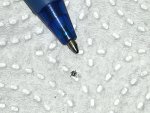poiuytrewq
Well-Known Member
My horse was having physio last week and the physio noticed a tick in his armpit. It was skin coloured not dark as I’d expect but she said they got dark over time and that it had probably not been there long at all.
So I went out and bought a tick remover, when I went to use it the tick was gone.
He still has a hard raised lump where it was attached. Maybe similar to a £2 coin. I can poke and squeeze it so it’s not painful.
Is this normal? I’ve never had a tick on a horse before!
So I went out and bought a tick remover, when I went to use it the tick was gone.
He still has a hard raised lump where it was attached. Maybe similar to a £2 coin. I can poke and squeeze it so it’s not painful.
Is this normal? I’ve never had a tick on a horse before!


